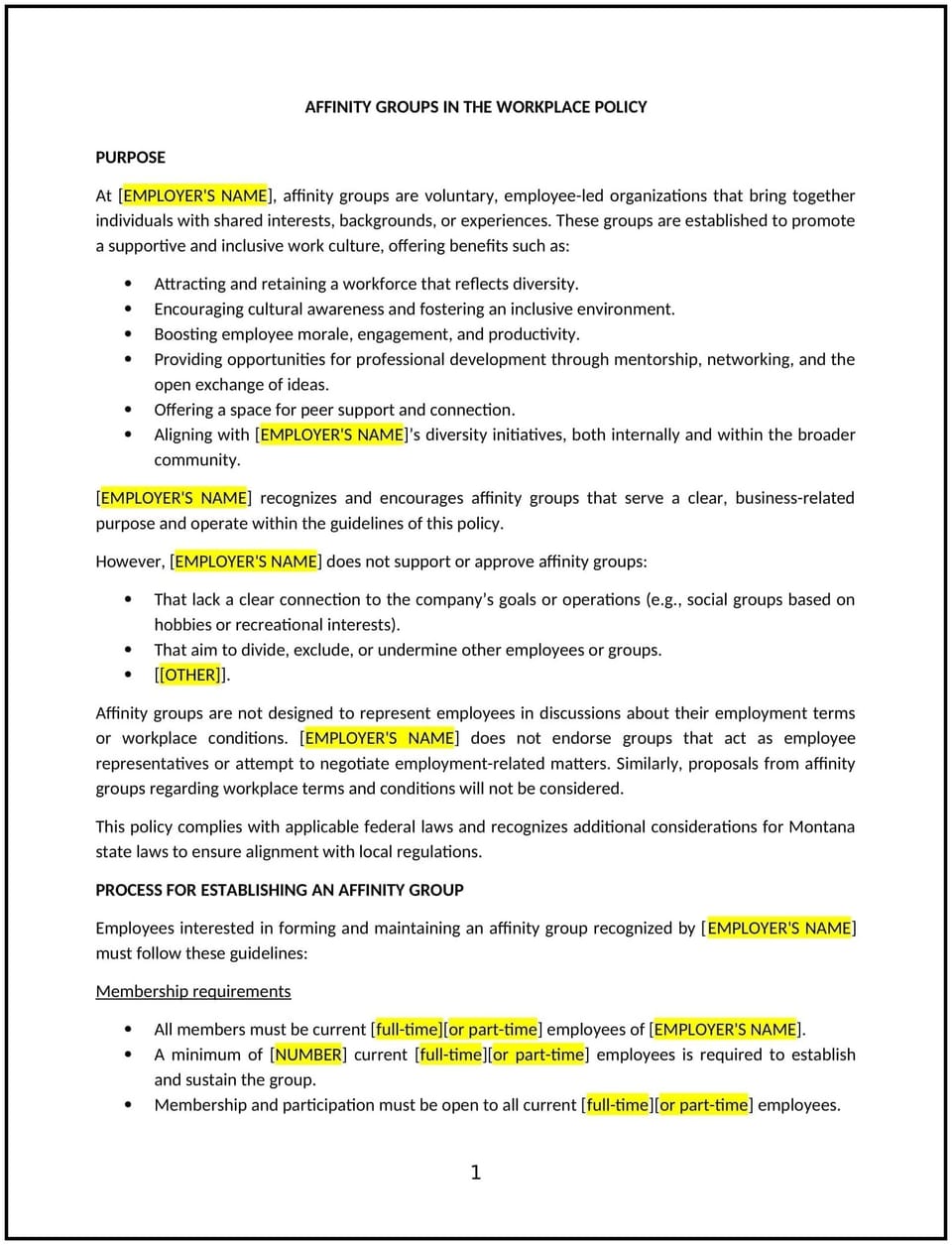Affinity groups in the workplace policy (Montana): Free template

Affinity groups in the workplace policy (Montana)
A well-defined affinity groups policy helps Montana businesses create a structured approach to employee-led groups based on shared interests, backgrounds, or experiences. This policy sets guidelines for forming, managing, and supporting affinity groups while maintaining inclusivity and alignment with business objectives. It helps businesses balance employee engagement with legal and operational considerations.
By implementing this policy, businesses can promote inclusivity, encourage employee connection, and create a structured approach to workplace affinity groups.
How to use this affinity groups in the workplace policy (Montana)
- Define eligibility and purpose: Businesses should specify the criteria for forming affinity groups, ensuring they align with workplace culture and company goals. This includes outlining the purpose, scope, and activities permitted under the policy.
- Establish approval and governance: Businesses should determine the approval process for forming new groups, including any required leadership oversight. Setting governance structures helps ensure groups operate within business guidelines.
- Address participation guidelines: The policy should clarify that participation is voluntary, inclusive, and free from pressure. Businesses should ensure that affinity groups are open to all employees and do not create exclusionary environments.
- Set operational expectations: Businesses should outline any company-provided support, such as meeting spaces, communication tools, or funding. Clear guidance helps affinity groups function effectively without disrupting daily operations.
- Maintain neutrality: Businesses should ensure that affinity groups remain workplace-appropriate and do not engage in political or divisive activities. This helps maintain a respectful and professional work environment.
- Define reporting and oversight: Businesses should designate a point of contact, such as HR, for oversight and support. This ensures that affinity groups operate within workplace policies and business values.
- Review and update as needed: Businesses should periodically review the policy to ensure it remains relevant to company needs and any changes in Montana labor laws or workplace culture.
Benefits of using this affinity groups in the workplace policy (Montana)
This policy provides several key benefits for Montana businesses:
- Encourages employee engagement: Well-managed affinity groups foster a sense of belonging and increase workplace satisfaction.
- Supports diversity and inclusion efforts: Businesses can use affinity groups to create a more inclusive workplace culture by promoting awareness and collaboration.
- Provides clear guidelines: A structured policy helps businesses manage affinity groups effectively, preventing confusion about expectations and participation.
- Reduces workplace conflicts: Clear rules ensure affinity groups function appropriately, preventing potential issues related to exclusivity, favoritism, or political discourse.
- Aligns with business objectives: By setting expectations, businesses can ensure that affinity groups support workplace culture and do not interfere with daily operations.
- Establishes a fair approval process: Businesses can maintain consistency by using a standardized approach for approving and overseeing affinity groups.
Tips for using this affinity groups in the workplace policy (Montana)
- Communicate the policy clearly: Businesses should share the policy with employees to ensure understanding of guidelines and expectations for forming and participating in affinity groups.
- Provide HR oversight: HR should be involved in reviewing affinity group proposals and providing guidance to ensure workplace appropriateness.
- Ensure voluntary participation: Businesses should emphasize that affinity group participation is optional and that employees should not feel pressured to join or lead groups.
- Monitor group activities: Businesses should periodically review affinity groups to ensure alignment with workplace policies and business values.
- Keep documentation: Businesses should maintain records of approved affinity groups, their leadership, and any company resources allocated to them.
- Address concerns promptly: If issues arise, businesses should resolve them fairly and in accordance with company policies.
Q: Why should Montana businesses establish an affinity groups policy?
A: Businesses should implement an affinity groups policy to provide structure and clarity for employee-led groups. A clear policy helps manage participation, prevent workplace conflicts, and ensure groups align with business values.
Q: What guidelines should businesses set for approving affinity groups?
A: Businesses should establish an approval process that includes submitting a proposal outlining the group’s purpose, leadership structure, and planned activities. The process should ensure that all groups align with workplace culture and do not promote exclusion.
Q: Can businesses provide funding or support for affinity groups?
A: Businesses may choose to allocate resources such as meeting spaces, communication platforms, or limited funding. However, they should establish clear criteria for what support is available and ensure consistency across all approved groups.
Q: How can businesses ensure affinity groups remain inclusive?
A: Businesses should require that all groups are open to any interested employees and do not create an environment that excludes others. HR should oversee group activities to maintain workplace inclusivity.
Q: Should businesses monitor affinity group discussions and activities?
A: Businesses should have a process for oversight but should avoid excessive monitoring that may discourage participation. Instead, HR or leadership can provide periodic check-ins to ensure groups remain workplace-appropriate.
Q: What steps should businesses take if an affinity group violates company policies?
A: Businesses should address violations through HR, following established disciplinary procedures if necessary. Any group that fails to adhere to workplace guidelines should be reviewed, and corrective action should be taken as needed.
Q: How often should businesses review their affinity groups policy?
A: Businesses should review the policy at least annually or when workplace culture shifts, labor laws change, or concerns about group management arise.
Q: Can businesses restrict certain affinity groups?
A: Businesses should apply approval criteria consistently. Groups that do not align with workplace values, violate policies, or promote exclusionary or divisive behavior may be restricted.
Q: Should affinity group participation impact employee performance evaluations?
A: Participation should remain voluntary and separate from performance evaluations. Employees should not face positive or negative consequences based on affinity group involvement.
This article contains general legal information and does not contain legal advice. Cobrief is not a law firm or a substitute for an attorney or law firm. The law is complex and changes often. For legal advice, please ask a lawyer.


